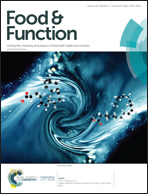Interactions of carbon quantum dots from roasted fish with digestive protease and dopamine†
Abstract
Food-borne carbon quantum dots (CQDs) in thermal-processed fish may pose potential risks to the human body. In this study, the CQDs were extracted and purified from salmon roasted at 200 °C for 50 min and the interactions of CQDs with digestive protease (pepsin and trypsin) and dopamine were investigated. The remarkable fluorescence quenching of pepsin and trypsin was found upon interaction with the CQDs via the static quenching mechanism. The pepsin or trypsin molecules became larger in size after binding with CQDs. The CQDs showed spontaneous interaction with pepsin and trypsin as confirmed by a negative Gibbs free energy change. The alteration of the circular dichroism spectra revealed a conformational change of pepsin and trypsin after CQD binding. The pepsin and trypsin activities were significantly inhibited when the CQD concentration was more than 1.0 × 10−5 mol L−1 and significant inhibition of casein digestion was found in the presence of CQDs in digestive juices. In addition, the Förster resonance energy transfer effect happened after the interaction between CQDs and dopamine. This study has shed light on a comprehensive mechanism of interactions of CQDs with digestive proteases and dopamine, which may provide useful information in understanding the potential influence of CQDs.



 Please wait while we load your content...
Please wait while we load your content...